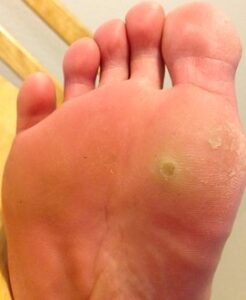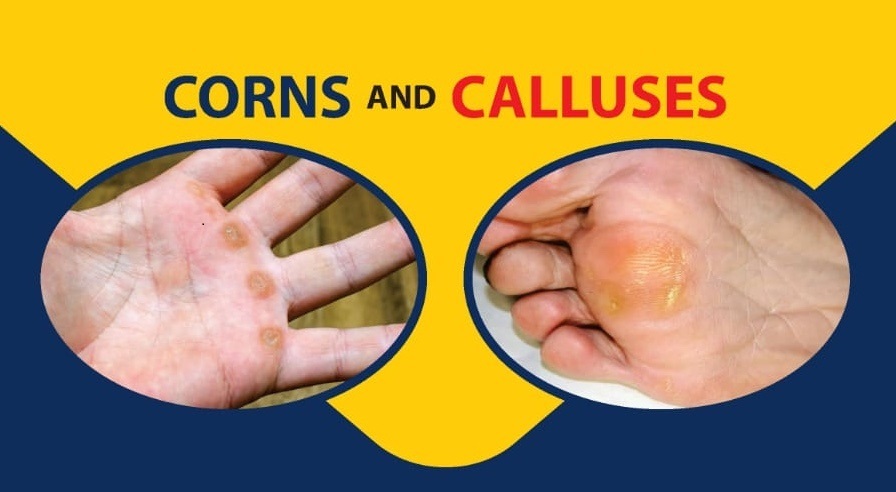
In This Article
- What does corn look like?
- Causes of corn and calluses
- Prevention of corns and calluses
- Corn on foot treatment
- FAQ’s
What does corn look like?

Corns and calluses are thick, hardened layers of skin that develop when your skin tries to protect itself against friction and pressure. They most often develop on the feet and toes or hands and fingers. Corns and calluses can be unsightly. They are caused by excessive pressure or rubbing (friction) on the skin and can lead to foot problems, especially on walking. The common cause is wearing ill-fitting shoes
You may have corn or callus if you notice:
- A thick, rough ares of skin
- A harden raised bump
- Tenderness or pain under skin
- Flaky, dry or waxy skin
Causes of corn and calluses:
Pressure and friction from repetitive actions cause corns and calluses to develop and grow:
- Wearing ill-fitting shoes. Tight shoes, high heels, or too loose footwears
- Wearing shoes without socks. Socks that don’t fit properly also can be a problem.
- Playing instruments or using hand tools causing repeated friction and pressure
Prevention of corns and calluses:
- Wear shoes that give your toes plenty of room.
- Use protective coverings. Wear felt pads or bandages over areas that rub against your footwear. Also can try toe separators or some lamb’s wool between your toes.
- Wear padded gloves when using hand tools. Or try padding your tool handles with cloth tape or covers.
Corn on foot treatment:
- Treatment for corns and calluses usually involves avoiding the repetitive actions that caused them to develop
- If a corn or callus persists or becomes painful despite your self-care efforts, then you should seek for Dermatologist coz they are the health care professional specialized in various treatments of corn and calluses
- A dermatologist can offer you various treatments like-
- Trimming away excess skin
- Callus-removing medication- salicylic acid, lactic acid
- Radiofrequency Excision
- CO2 Laser Excision
- Surgical Excision depending on clinical needs
FAQ's
- What does corn on foot look like?
- A thick, rough area which may appear raised bump, hard to feel on touch and maybe painful sometimes
- How do I remove corn on my foot?
- In the early stages soaking part in water for few minutes and rubbing with a pumice stone can help to get rid
- How do you get rid of deep corns?
- For deep corn need it’s always recommended to consult a Dermatologist coz they are specialized in various treatments of corn and calluses depending on clinical severity.
- What happens if corn is left untreated?
- If corn remains unattended for long sometimes may lead to complications like an increase in size, ulceration, infection, difficulty in walking, and can lead to deformities.
- What is the best corn removal product?
- Many exfoliating scrubs, lotions, and ointments contain salicylic acid, lactic acid, benzoic acid or its combinations are available. They need to be used under the supervision of a Dermatologist. There are also direct treatment options, including corn pads containing salicylic acid, but most of the time improper size and improper use of corn pads leads to complications and better to be avoided.
- Does removing corn leave a hole?
- In enucleation or surgical excision of corn tissue will leave a dimple or hole in the tissue of the foot. In the subsequent process of healing, it will get filled with natural health tissue.
- Does Vaseline help corns?
- Heavy moisturizing creams or petroleum jelly, such as Vaseline can help soften the calluses and prevent the skin from drying out.
- How do you treat corns at home?
- Wear thick, cushioned socks.
- Wear wide, comfortable shoes with a low heel and soft sole that do not rub.
- Use soft insoles or heel pads in your shoes.
- Soak corns and calluses in warm water to soften them.
- Regularly use a pumice stone or foot file to remove hard skin.
- Moisturise to help keep skin soft.
We hope the above information will definitely find you helpful if you are facing the issue of corn and calluses. However, if you aren’t sure what is causing your corn or callus, if the hardened skin is very painful, or if you have diabetes, see a dermatologist. It’s always recommended that get yourself examined by a Dermatologist, and plan treatment appropriately.


